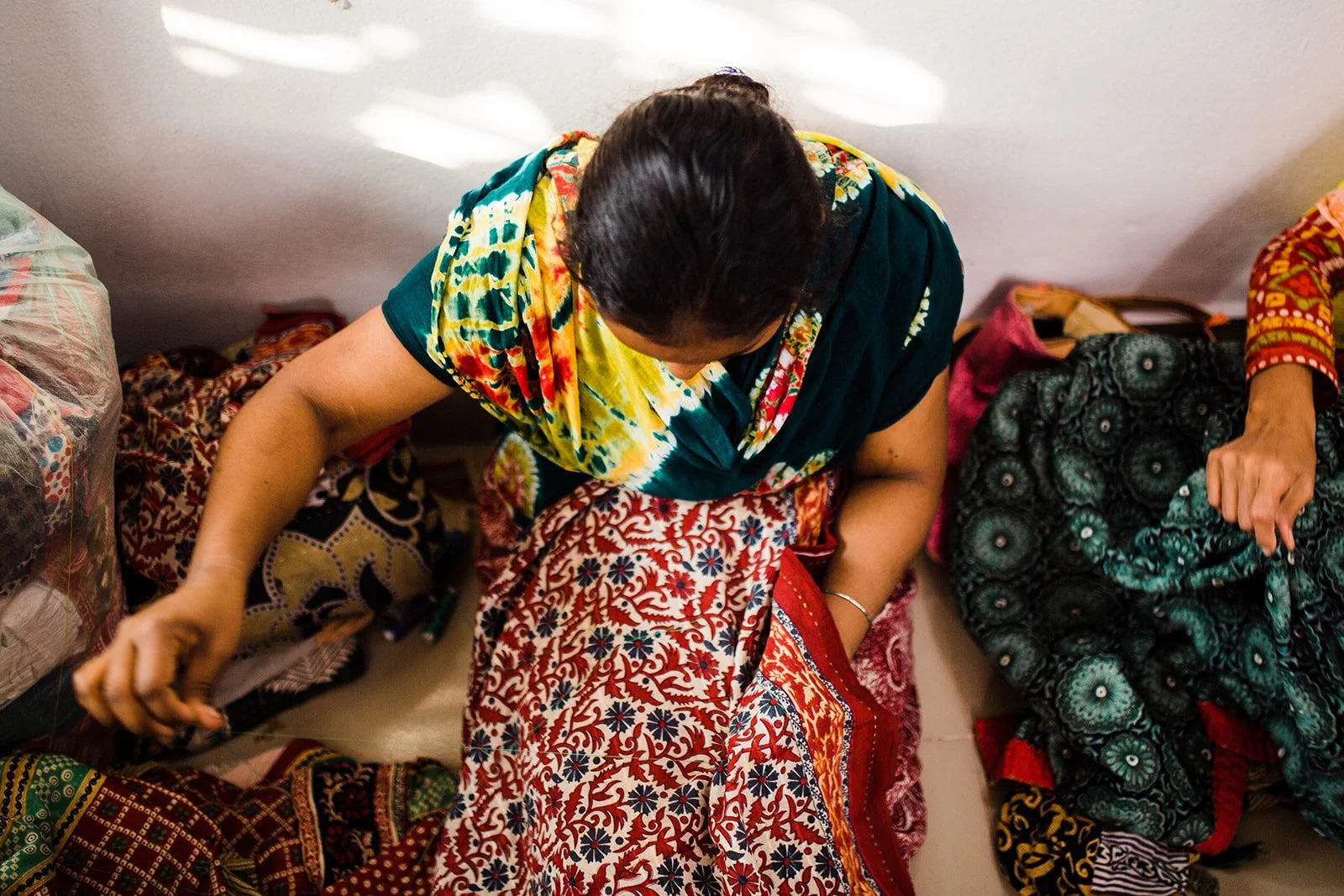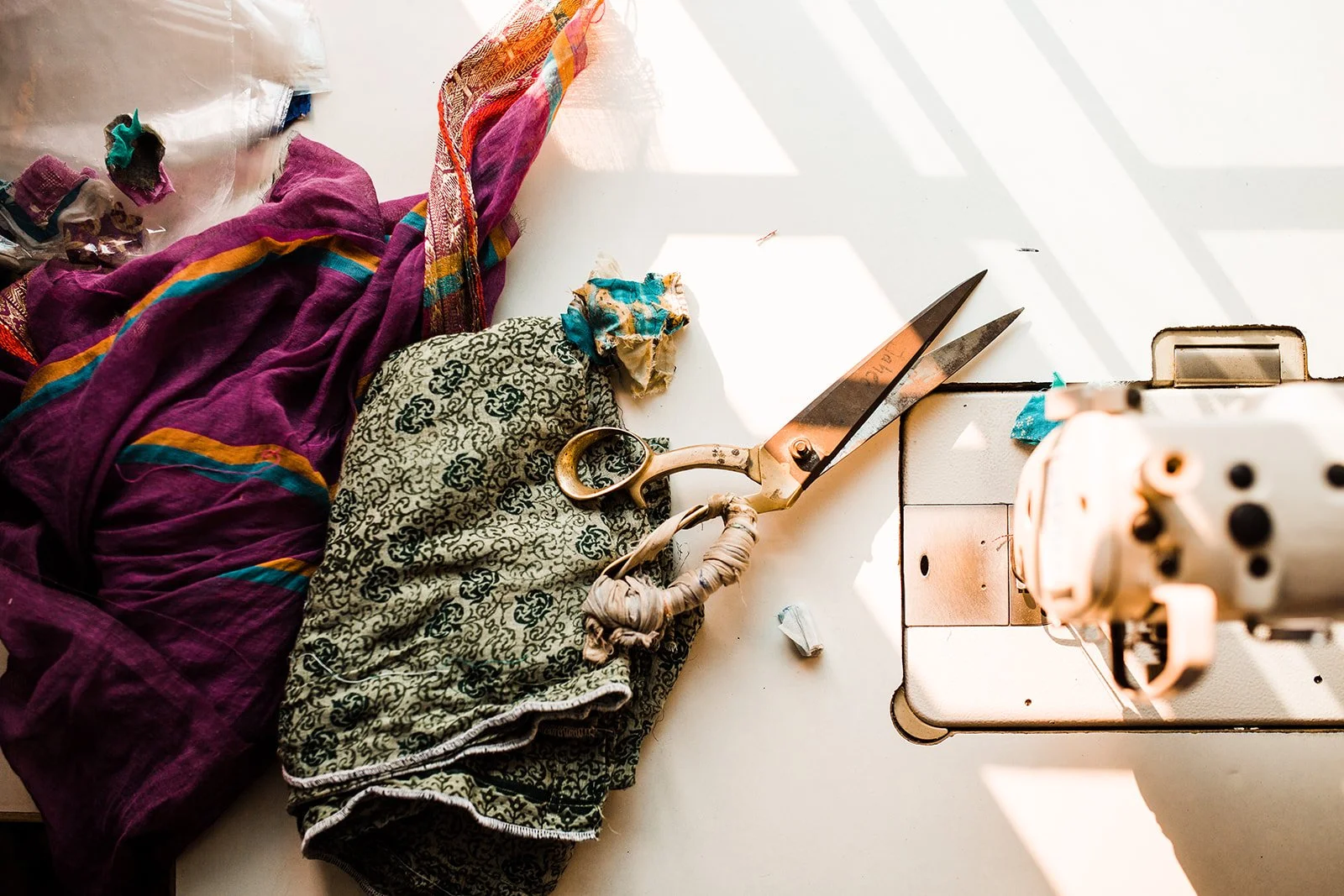'Kantha, making whole again that which was fragmented or broken.'
Crafts Museum, New Delhi
The kantha stitch has been passed down from one woman to another for many generations. These timeless pieces with their tiny stitching and unique patterns never grow old, maybe that's why the art of kantha has been around for over 500 years.
Kantha refers to the type of stitch used in the craft of this specific type of embroidery, where old sari is mixed and layered and stitched together, creating a vintage quilt. This specific stitch gives the quilts a textured, wavy, quality, with each quilt being unique and having its own story.
Far from trend-setting, or even artfulness, kantha was born of need, lovingly stitched by mothers to keep their children and families warm, comprised of their old sarees, pierced, layered and stitched together with love and care.
THE HISTORY
Born in the rural villages of Bengal, kantha has an ancient stitching history, it is one of the oldest forms of embroidery and its origins can be traced back to the pre-Vedic ages, prior to 1500BCE. However, the first written mention of kantha is found in the poet Kaviraj's book 'Chaitanya Charitamrita', 500 years ago, in which the poet writes about how a mother sent a homemade kantha to her son in Puri through some travelling pilgrims.
An ancient myth also details Lord Buddha and his disciples using old rags with different kinds of patchwork to cover themselves at night, giving kantha embroidery its origin. 'Kantha' translates roughly to ‘rags’, referring to the reclaimed nature of the vintage fabrics and repurposing methods in which Kantha quilts are created. The majority of kantha was used as light coverlets during the mild Bengali winters and breezy monsoon nights.
Kantha, as an art form, all but disappeared in the early 19th century before being revived in the 1940s by the daughter in law of Bengali poet, Rabindranath Tagore. Kantha's revival was again disrupted in 1947, during the Partition of India, and the resulting conflict between India and what was then Eastern Pakistan (now Bangladesh). Since the Bangladesh Liberation War in 1971 kantha has experienced a rebirth as a much desired art-craft form.
Far more beautiful than the original name inspires, Kantha quilts are a vibrant patchwork of layer upon layer of patterned fabrics, bold colours and of course a rich history, woven together with each stitch, patch and stretch of beautiful fabric.
THE PROCESS
Traditionally, old cotton saris, lungis and dhotis, which had turned very soft through wear, were used to make kanthas, with the thread for the stitching drawn out from the fabric borders. The height of recycling!
Historically, textile production was one of the most labour-intensive industries, thus textiles were highly valued. Therefore the recycling of well used cloth was a natural step in the lifecycle of textiles. As this recycling was home-based work, it usually fell to the women of the village to prepare, cut and stitch the rags - giving old textiles new life.
To make kantha fabric, approximately five to seven old sarees are layered together on the ground and ironed. A large, loose basting stitch is used around the edge of the fabric to hold the layers together. The artisan then uses a running stitch or 'kantha stitch' across the length and width for holding the layers together. The stitch covers the entire cloth to provide strength.
The patterned running stitches across the width of the fabric give the cloth a rippled look and feel. The designs range from simple to intricate, depending on the skill and the interest of the embroiderer. While Hindu women might depict daily activities or stories around a central floral image in their design, Muslim women use the combination of geometric and floral design.
Traditionally, kantha was made over a long period of time for use by the family; every family in Bengal having a number of kanthas for personal use. It could take months or even years to complete one kantha. The stitching could be handed down through generations, with grandmother, mother and daughter working on the same kantha.
Over time, kantha developed as a generational skill, a craft that could symbolically impart story, desire, and well-wishing for loved ones and gift recipients. Elaborate kantha were made as wedding gifts or gifts for mothers, with stories and wishes weaved in, allowing illiterate women to leave a lasting mark.
THE STITCH
In modern usage, kantha generally refers to the type of stitch used.
The earliest and most basic kantha stitch is a simple, straight, running stitch, like the type used on our beautiful Basha quilts.
Running kantha can be further classified into that using figures and story telling (nakshi kantha) or geometric patterns (par tola kantha).
'Nakshi kantha' comes from the Bengali word, naksha, which refers to artistic patterns. It is made up of motifs influenced by religion, culture and the lives of the women stitching them. Kanthas told of religion, folklore and the personal lives of the artisans; their dreams, hopes and everyday life. Motifs included birds, animals, flowers and folk scenes.
'Par tola' kantha has evolved along the lines of traditional Islamic art which focuses on geometric patterns rather than life forms (which are discouraged by the Quran).
KANTHA TODAY
Today, the rich tradition of kantha has gained popularity in the West; no surprise, given the beauty and intricacy of each piece. Kantha embodies our cultural trend away from throw away consumer goods, and towards more meaningful, handcrafted goods with a low environmental impact.
The majority of kantha production is made for commercial consumption - both domestically in India and Bangladesh, and for the export market. In theory, this is a positive thing for the rural women of Bengal, who are limited by economic, cultural, social and religious factors from finding gainful employment outside of their homes - as it offers them the opportunity to craft kanthas for this increasing market. However, in practice, kantha artisans suffer the same exploitation as their brothers and sisters working in almost every handicraft sector in the region.
The Journal of Social Work and Social Development’s study of kantha artisans, discovered that the majority of women were cheated on payments owed to them, suffered from late or irregular payments, and were socially immobile due to an absence of training. It was found that the average annual income from kantha production was a meagre Rs.2,000-4,000 (USD 30 - 60) per artisan, far below anything which could be considered a living or fair wage.
Happily, there are a growing number of designers becoming more conscious of the importance of applying fair trade principles to their work, and it's possible to find ethically produced kantha products, like those we make at Kantha Karma.





